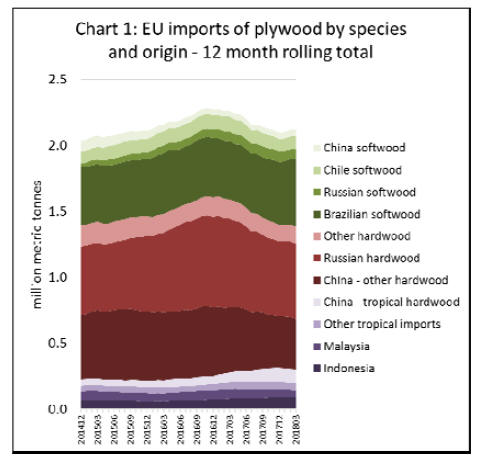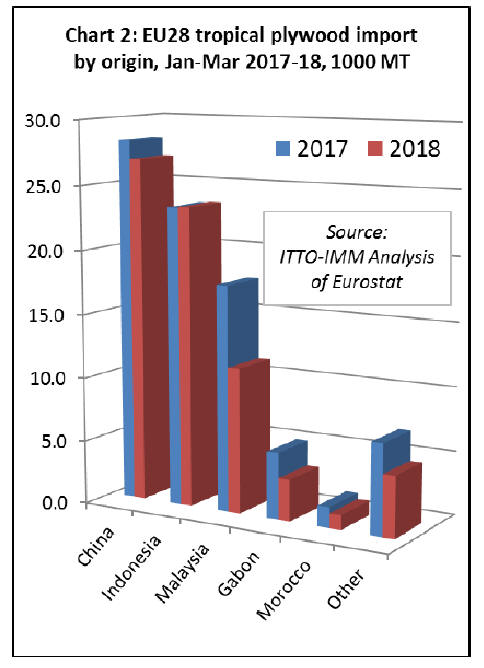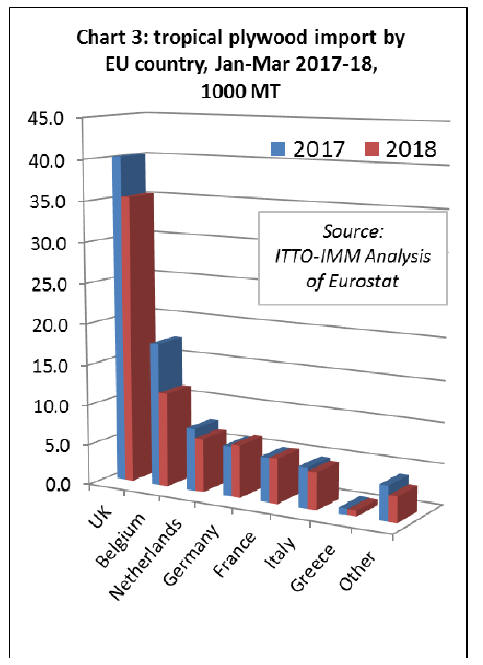|
Report from
Europe
Firming demand for plywood in EU but sales suffer
from supply problems and price rises
The European plywood market faces a combination of
buoyant demand, mounting competition for product from
other leading consumer countries plus persistent supply
delays and constraints among key producers, notably
tropical suppliers.
In fact, tropical suppliers actually saw their exports to
Europe fall in the first quarter of 2018. The overall result
of these factors has been rising prices, increasing caution
about forward buying and, if not shortages, longer lead
times and difficulties, as one importers said, ¡®in planning
ahead and obtaining the right volumes at the right time¡¯.
Concerns have also been raised in the industry once more
about mis-marking of Chinese plywood imports in terms
of timber species mix and recommended application
labelling. This has been voiced particularly by the UK
Timber Trade Federation (TTF), which has consequently
issued new product performance and content checking
protocols for its members.
Boost from European construction
The key driver of European plywood demand has been the
continuing buoyant state of construction across most of the
EU. This is underpinned, according to market monitor and
analyst Euroconstruct, by generally robust wider economic
performance, low interest rates, migratory flows,
particularly into urban centres, and the latent demand that
has built up due to the building investment backlog since
the economic crisis.
The latest Euroconstruct report, published on June 11 and
charting building sector development in its network of 19
European countries describes their current construction
growth as ¡°exceptional¡±. It adjusts its estimate for 2017
expansion of the industry, forecast in November last year
at 3.5%, to 3.9%. This gives the industry turnover of
euro1.52 trillion, comprising 49% new build and 51%
renovation, repair and refurbishment. It also predicts, with
building levels still 20% off their 2007 market peak, that
there is more growth to come through 2018 (2.4%) into
2019 (1.9%).
¡°Never before have all Euroconstruct countries¡¯ building
industries grown for two years in a row,¡± states the report.
Fastest 2018 construction expansion is expected in
Hungary, forecast at a rate of 24.6%, Ireland 11.1% and
Poland 9.9%, with the worst performance in a ¡®barely
positive¡¯ UK market, where poorer economic performance
is expected to keep growth down to just 0.1%.
Having said that, the UK will remain the third biggest
construction market in Europe, with a value of euro210.9
billion, after Germany (euro332 billion) and France
(euro216 billion), but ahead of Italy (euro169.4 billion).
New residential construction has recently been the main
engine of European construction growth, increasing last
year by 10%. That rate, says Euroconstruct, will halve in
2018, but civil engineering will take over as the key
market driver, expanding 5%.
This, said one importer, will be positive for plywood
demand, as will growth in renovation, which,
Euroconstruct says, will ¡®continue for a long time and on
average exceed and be more stable than growth in new
construction¡¯.
Solid plywood demand, rising prices
Against this background, European plywood importers
variously describe demand ranging from ¡®stable and
sound¡¯ and ¡®at a good level¡¯, to ¡®strong and strengthening¡¯.
Most companies said sales were solid across the range,
although Malaysian generally and Indonesian marine
plywood were highlighted as being particularly sought
after.
At the same time, all importers had issues with supply in
different degrees. ¡°There have been delays from
everywhere, for various reasons,¡± said one leading
continental operator. ¡°Overall supply is short, making it
difficult to plan,¡± confirmed a UK company. ¡°Mills are
also often running very late.¡±
The problems with Indonesian and Malaysian supplies are
largely attributed by European importers to the long and
severe wet season and its impact on harvesting and log
transport, with mills consequently running short of logs.
The weather and raw material supply situation has since
improved, but a report in the European trade press early
April said that in some regions ¡®logging roads are still
muddy and log hauling is difficult¡¯, adding that it could
take a further month before the situation returned to
normal.
Plywood prices for both Malaysia and Indonesia in the EU
are reported to have increased by 30% in the last six
months.
Until recently, supply from Brazil was described by
European importers as ¡®no better or worse than usual¡¯, but
the recent nationwide truckers strike over high fuel prices
is expected to cause continuing delays in delivery of raw
material to mills and finished product to port.
President Temer ultimately made concessions to the
strikers and industrial action was called off end of May,
but the country was left with a significant backlog of
undelivered cargo and the action is now expected to dent
GDP.
Increased competition from US buyers for Malaysian and
Indonesian product is also said to be impacting availability
and price in Europe.
¡°Traditionally, US buyers have sourced Asian hardwood
plywood imports most heavily from China [worth $1.12
billion last year], but their requirements are now such that
they¡¯ve been exploring other sources, including Indonesia
and Malaysia,¡± said a European importer/distributor.
¡°Whether US anti-dumping and countervailing duties on
Chinese hardwood products, activated in December, will
heighten this trend remains to be seen.¡±
China¡¯s plywood trade disrupted by domestic
environmental controls
Meanwhile Chinese plywood supply is reported by EU
importers to be disrupted by tough new national
environmental controls, which are forcing mills to
interrupt production to upgrade or replace emission and
waste treatment technology. Here prices are reported to
have risen 10% in the last six months.
¡°Inspectors have been visiting our Chinese supplier mills
now for months, and we¡¯ve seen regular stoppages as they
improve their systems,¡± said one importer/distributor.
¡°And recently there were more in Linyi and Pizhou.¡±
¡°Stoppages also increased in Qingdao as part of the
authorities moves to improve the local environment for
June¡¯s Shanghai Cooperation Organisation meeting,¡± said
another leading EU importer.
Some European traders maintain that one reason for the
pollution crackdown is to rationalise and concentrate the
plywood industry, forcing smaller producers to close.
One European importer/distributor, however, insisted this
was not the prime objective. ¡°We visit regularly and are
convinced it¡¯s motivated by a genuine desire to reduce the
industry¡¯s environmental footprint and help meet climate
change targets,¡± he said. Importers added that they
generally back China¡¯s action as underpinning its overall
environmental credibility.
As for the situation with Russian hardwood plywood
supplies to the EU, an importer summed it up as ¡®more or
less OK¡¯. ¡°But there have been some issues with a lack of
trucking capacity,¡± he said.
EU plywood imports up 5% in first quarter
Analysis of latest trade figures for plywood supply to the
EU tally with importers¡¯ comments. Total EU plywood
imports have picked up a little this year, hitting 686,000
cu.m in the first quarter, nearly 5% more than the same
period in 2017. However, supply constraints have meant
that imports are still well below levels prevailing two
years ago in 2016. (Chart 1).

Lack of supply has been a significant drag on EU imports
of tropical hardwood plywood this year. Imports from all
the EU¡¯s leading tropical suppliers except Indonesia
declined in the first quarter of 2018 (Chart 2).

The volume of EU plywood imports from Indonesia
increased only slightly, by 0.3% to 23,000 tonnes, in the
first quarter of 2018. However, import value from
Indonesia fell 10.9% to euro23.9 million during the period.
In the first quarter of 2018, EU imports of tropical
hardwood plywood from China contracted 16.5% by value
to euro16.5 million and 5% in volume to 26,900 tonnes,
and Malaysia¡¯s were down 40% to euro8.4 million and
36% to 11,350 tonnes.
Imports from Gabon were 37% lower by value at euro4.6
million and 37.5% by volume to 3,250 tonnes, and from
Morocco down 29% by both value and volume to euro1.9
million and 1,137 tonnes.
Together with other sources, this meant total first quarter
EU tropical plywood imports were 23% lower by value at
euro61.9 million and 15% by volume to 74,029 tonnes.
By individual EU country, in the first quarter of 2018,
imports of tropical plywood declined in the UK by 12% to
35,331 tonnes, Belgium by 34% to 11,630 tonnes,
Netherlands by 15% to 6,601 tonnes, Italy by 8% to 4,592
tonnes and Greece by 7% to 723 tonnes.
In contrast, German imports increased 5% to 6,480 tonnes
and French imports were up 32% to 5,530 tonnes in the
first quarter of 2018. (Chart 3).

EU first quarter imports of ¡®other¡¯ (i.e. non-tropical)
hardwood plywood from Russia, China, Ukraine, Belarus,
Bosnia Herzegovina, Uruguay and Brazil and other
suppliers were 276,042 tonnes, a 2% gain against 269,471
in the first quarter of 2017.
Softwood imports, primarily from Brazil, Russia, Chile,
China, South Africa, Uruguay, Canada and Norway, were
335,590 m3 in the first quarter of 2018, 13% more than the
same period in 2017.
Plywood importers comments on FLEGT licensing
Asked about FLEGT licensed Indonesian plywood,
importers interviewed for this market report said it had not
had significant impact on their purchasing or sales.
One commented that this was related to lack of supply
from Indonesia generally. Another said that they had
recently seen an upturn in demand for marine ply from
Indonesia. ¡°But that¡¯s been due primarily to the excellent
quality from our suppliers,¡± he said.
Importers also cited customer¡¯s preference for FSC and
PEFC certification, with FLEGT licensing regarded as a
¡®bonus form of legality verification¡¯. ¡°We still don¡¯t
believe that enough is known about FLEGT licensing or
the wider FLEGT Voluntary Partnership Agreement
initiative in the marketplace, particularly in terms of itson
the ground impacts in the supplier country,¡± said an
importer.
¡°We still need more communication on FLEGT generally,
with awareness greater among our customers of
Indonesia¡¯s long-established SVLK timber legality
assurance system, which became the TLAS of its FLEGT
VPA, than FLEGT itself. Certainly, little is known of the
sustainability aspects of FLEGT licensing.¡±
UK TTF Managing Director David Hopkins took up the
themes of awareness and market impact of FLEGT
licensing at the recent FLEGT Independent Market
Monitoring Trade Consultation in Nantes, France at the
end of May. He urged the EU industry to press their
national governments to accept a FLEGT licence as
evidence of full compliance with their timber purchasing
policy, which currently only those of the UK and
Luxembourg do.
¡°We actively promote the fact to the market that the UK
government accepts a FLEGT licence as ¡®Category A¡¯
proof of legality and sustainability on a level with what we
regard as branded certification businesses, FSC and
PEFC,¡± he said.
The UK TTF has also taken steps to ensure Chinese
plywood satisfies standards claimed in documentation and
labelling. After a year-long review of the market, it has
now established a new ¡®plywood framework¡¯ within its
compulsory Responsible Purchasing Policy.
This demands that UK TTF members ensure third-party
testing of glue bonds and obtain all relevant paperwork on
suppliers¡¯ factory production controls. The TTF stipulates
too that all packs should be marked with product technical
class and timber species used. It has also started a market
education programme to tackle ¡®ignorance about plywood
classes and their application¡¯.
Cautious optimism about future EU plywood demand
Looking to the future, despite recent supply issues and
price hikes, EU importers say that they remain cautiously
optimistic to upbeat about prospects for the rest of the
year.
Demand in coming months was variously predicted to be
¡®stable¡¯ to ¡®robust¡¯ and customers are reported to be
broadly accepting the reasons for price rises.
¡°When they see it¡¯s across the market and effectively out
of our hands, they pay the increase,¡± said one company.
Supply from Asia is also expected to improve as the dry
season improves raw materials flows and Chinese mills
complete implementation of the new environmental rules.
There is also some positive news from France¡¯s Rougier
Group, whose African operations entered creditor
protection earlier this year.
Speaking at the Carrefour International du Bois exhibition
at the end of May, Romain Rougier said that, while the
Group is exploring various options for its troubled
Cameroon operations, it is determined to stay in Africa in
the form of its successful and growing Gabon business,
which includes its 37,000m3 per year plywood mill.
Underscoring this commitment, Rougier used the French
show to launch Mokalam, a new range of thermally
modified cladding from Gabon based on okoum¨¦ and
frak¨¦, with plans to add further species.
|